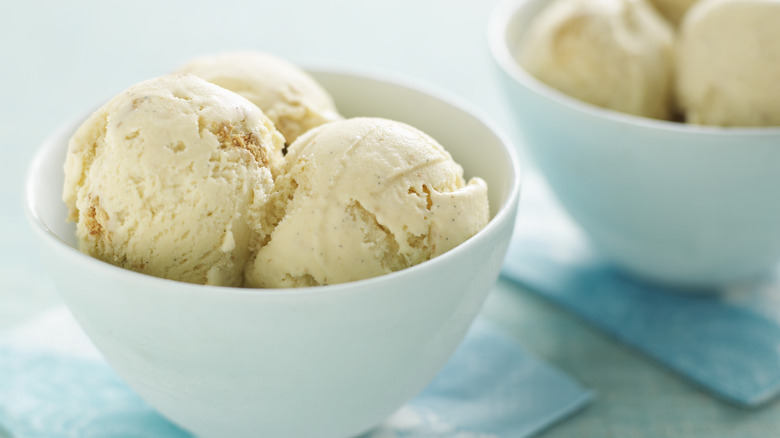Gelato Vs Ice Cream: Is There A Nutritional Difference?
If you're someone who's really into frozen desserts, then you probably know the subtle differences between how ice cream tastes versus gelato — and you probably have a preference between the two. But you may not know the details of the nutritional differences. If you've ever made ice cream at home, then you have an idea as to what goes into it; gelato contains the same basic ingredients — such as sugar, milk, and cream. However, each dessert contains a different ratio of those ingredients, which explains the nutritional differences.
Gelato and ice cream area similarly sweet — a typical ½ cup portion of gelato has 17 grams of sugar, while an equal amount of ice cream has 16 grams. Meanwhile, ice cream contains more heavy cream, and more cream means that ice cream has a higher fat content than gelato does. Specifically, ice cream, by definition, must contain at least 10% milk fat — and most ice creams land somewhere between 14 % and 25% milk fat. Gelatos have a milk fat content that is significantly lower than ice cream, usually, it falls somewhere between 4 and 9%.
What about the different types of ice cream?
When it comes to breaking down the nutritional facts of ice cream, we also need to specify the differences between French ice cream and American ice cream (the latter of which is also referred to as Philadelphia-style). The most prominent defining factor is that French-style ice cream is made with egg yolks, which gives it a more custardy flavor and texture. The inclusion of egg yolks also contributes to the fat content, especially since a batch doesn't just call for one or two egg yolks. For example, certain recipes for French vanilla ice cream calls for a total of 12 egg yolks (for eight servings).
Meanwhile, you may have noticed a similar product that looks like ice cream but is called "frozen dairy dessert." A frozen dessert is made with ingredients such as vegetable oils, artificial fillers, and other highly processed ingredients. A frozen dessert doesn't need to achieve the 10% milk fat content that ice cream does — which is why it isn't labeled as "ice cream" — so it may not even contain milk or cream at all. Additionally, a dessert labeled "ice cream" must weigh 4 ½ pounds to the gallon, which ensures that there isn't too much air churned into the product. A "frozen dairy dessert" doesn't have the weight requirement, so it may contain more air — which is overall cheaper for the company (as they are technically selling less product).
Should you choose gelato or ice cream?
Even though ice cream has a higher fat content and gelato has marginally more sugar, there really isn't a huge overall nutritional difference between the two frozen desserts. Instead of thinking about the nutritional value, it's more conducive to thinking about the texture and flavor differences when you need to decide between the two.
Ice cream has a lighter, more airy texture because it's churned at a higher speed than gelato. Gelato has a denser, smoother texture. Additionally, gelato tends to have more of a burst of intense flavor, while ice cream's flavor may be a bit more subdued. With this in mind, ice cream may be the better choice for a topping-packed ice cream sundae, since the milder flavor is easier to pair with other ingredients. So, if you're in the mood for something topped with hot fudge and sprinkles, you may want to choose ice cream — and be sure to peruse all of the ways to upgrade your sundae. However, if you're more in the mood for something simple yet intensely flavorful, gelato is probably the way to go.


